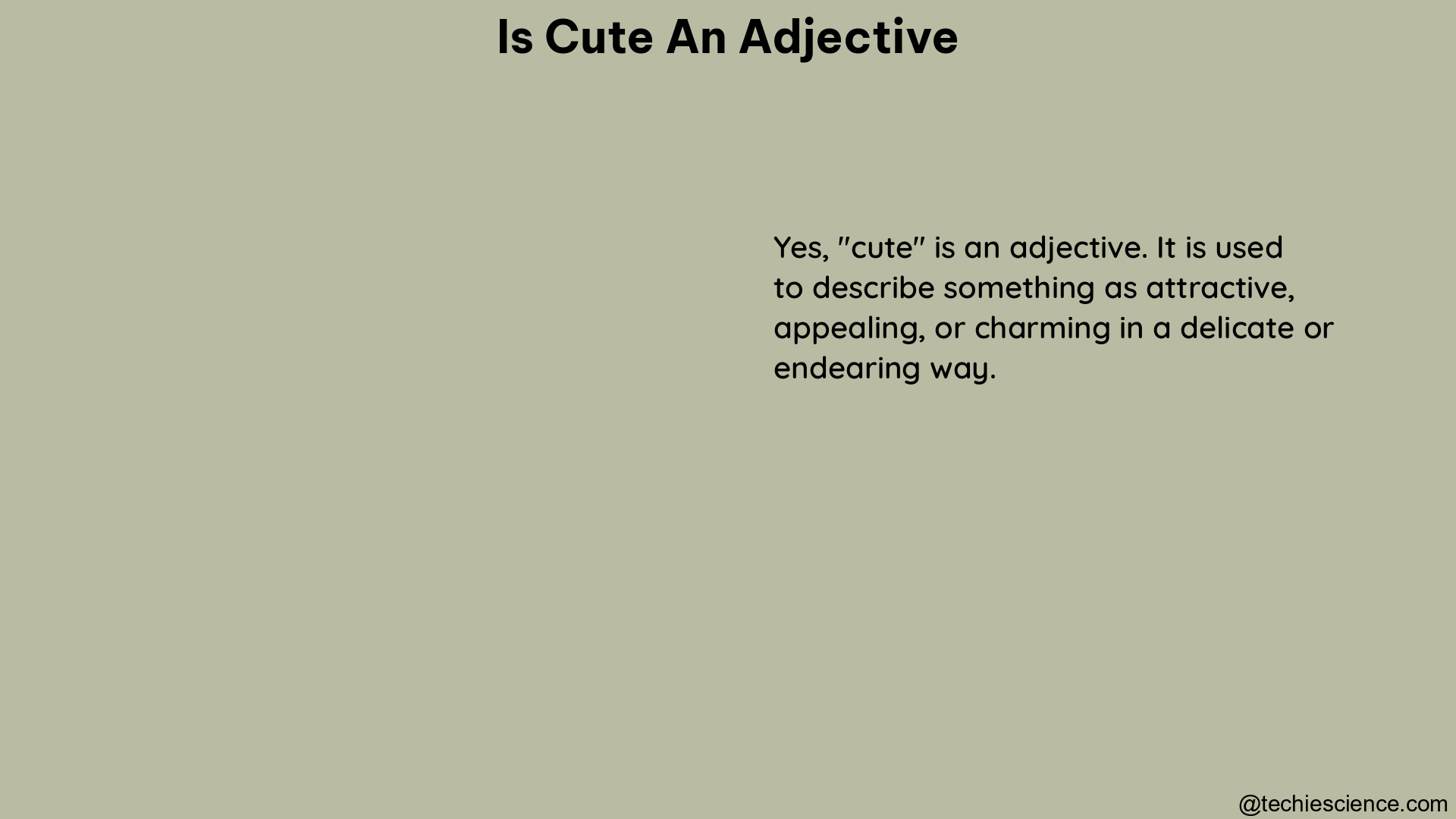Yes, “cute” is an adjective that has several distinct meanings and usages. Understanding the nuances of this versatile word is crucial for effective communication and writing in the English language. In this comprehensive guide, we will delve into the various facets of the adjective “cute” and provide a detailed analysis to help you master its application.
The Multifaceted Nature of “Cute” as an Adjective
The adjective “cute” can be used to describe a wide range of subjects, from physical appearances to personality traits. Let’s explore the three primary ways in which “cute” is employed as an adjective:
1. Attractive or Pretty
The most common usage of “cute” is to describe something or someone as pleasingly attractive, especially in a delicate or youthful manner. This can apply to a variety of subjects, such as:
- Babies: “That newborn baby is so cute!”
- Animals: “The puppy has the cutest little paws.”
- Physical features: “She has a cute nose and dimples.”
- Clothing or accessories: “That dress is so cute, I want one just like it.”
In this context, “cute” conveys a sense of endearment, charm, and visual appeal.
2. Clever or Shrewd
The adjective “cute” can also be used to describe someone as clever or intelligent, often in an underhanded or annoying manner. This usage typically implies a certain level of manipulation or slyness. For example:
- “She had a really cute idea to get out of doing her homework.”
- “Don’t get cute with me, young man. I know what you’re up to.”
In these cases, “cute” suggests a level of cunning or mischievousness, rather than physical attractiveness.
3. Overly Sentimental or Annoying
Finally, “cute” can be used to describe something as overly sentimental or trying too hard to be charming. This usage often carries a negative connotation, implying that the subject is excessively or artificially adorable. Examples include:
- “That picture of the two kittens is unbearably cute.”
- “The movie’s too cute to be taken seriously.”
In this context, “cute” is used to criticize or dismiss something as being overly saccharine or contrived.
Grammatical Considerations for Using “Cute” as an Adjective

As an adjective, “cute” can be used in various grammatical constructions to modify nouns and pronouns. Here are some key points to consider:
Placement in a Sentence
The adjective “cute” can be placed before the noun it modifies, as in “a cute puppy.” Alternatively, it can be used in a predicate position, as in “The puppy is cute.”
Comparative and Superlative Forms
Like many adjectives, “cute” can be used in comparative and superlative forms to indicate degrees of cuteness. The comparative form is “cuter,” and the superlative form is “cutest.” For example:
- “That kitten is cuter than the other one.”
- “She has the cutest smile I’ve ever seen.”
Adverbial Use
While “cute” is primarily an adjective, it can also be used as an adverb to modify verbs or other adjectives. In this case, the adverbial form is “cutely.” For instance:
- “She dressed cutely for the party.”
- “The puppy behaved cutely when the guests arrived.”
Contextual Considerations for Using “Cute” as an Adjective
The usage of “cute” as an adjective can be influenced by various contextual factors, such as:
Tone and Connotation
The tone and connotation of “cute” can vary depending on the context. In some cases, it may convey a positive, endearing sentiment, while in others, it may carry a more negative or dismissive undertone.
Audience and Formality
The appropriateness of using “cute” as an adjective can also depend on the audience and the level of formality required. In formal or professional settings, it may be more prudent to use alternative adjectives that convey a similar meaning but are perceived as more sophisticated.
Cultural and Personal Preferences
The perception and usage of “cute” as an adjective can also be influenced by cultural and personal preferences. What one individual considers “cute” may not be viewed the same way by another, depending on their background, experiences, and individual tastes.
Mastering the Nuances of “Cute” as an Adjective
To effectively use the adjective “cute” in your writing and communication, consider the following tips:
- Understand the Contextual Meanings: Be mindful of the different connotations and implications of “cute” in various contexts, and choose your usage accordingly.
- Vary Your Vocabulary: While “cute” is a versatile adjective, overusing it can make your writing appear repetitive or lacking in sophistication. Explore alternative adjectives that convey similar meanings, such as “adorable,” “charming,” “endearing,” or “attractive.”
- Consider Your Audience: Adjust your use of “cute” based on the formality of the situation and the preferences of your audience. In formal or professional settings, it may be more appropriate to use more formal adjectives.
- Pay Attention to Tone and Connotation: Ensure that your use of “cute” aligns with the overall tone and message you want to convey. Avoid using it in a way that could be perceived as condescending or dismissive.
- Experiment with Comparative and Superlative Forms: Explore the use of “cuter” and “cutest” to add nuance and emphasis to your descriptions.
- Utilize Adverbial Forms Judiciously: Use the adverbial form “cutely” sparingly, as it can sometimes come across as overly sentimental or forced.
By mastering the nuances of the adjective “cute,” you can enhance your written and verbal communication, ensuring that your use of this versatile word is both effective and appropriate.
Reference:
- Oxford Learners Dictionaries. (n.d.). cute adjective – Definition, pictures, pronunciation and usage notes. Retrieved from https://www.oxfordlearnersdictionaries.com/us/definition/american_english/cute
- Oxford Learners Dictionaries. (n.d.). cute adjective – Definition, pictures, pronunciation and usage notes. Retrieved from https://www.oxfordlearnersdictionaries.com/us/definition/english/cute
- Cambridge English Dictionary. (n.d.). CUTE | definition in the Cambridge English Dictionary. Retrieved from https://dictionary.cambridge.org/us/dictionary/english/cute
- Dictionary.com. (n.d.). CUTE Definition & Meaning – Dictionary.com. Retrieved from https://www.dictionary.com/browse/cute
- Merriam-Webster. (n.d.). Cute Definition & Meaning – Merriam-Webster. Retrieved from https://www.merriam-webster.com/dictionary/cute

Hi…..I’m a graduate with a Bachelor’s degree in English Literature. I wish to do a Masters in the same field someday and continue my career in Academia.
Let’s connect through LinkedIn: